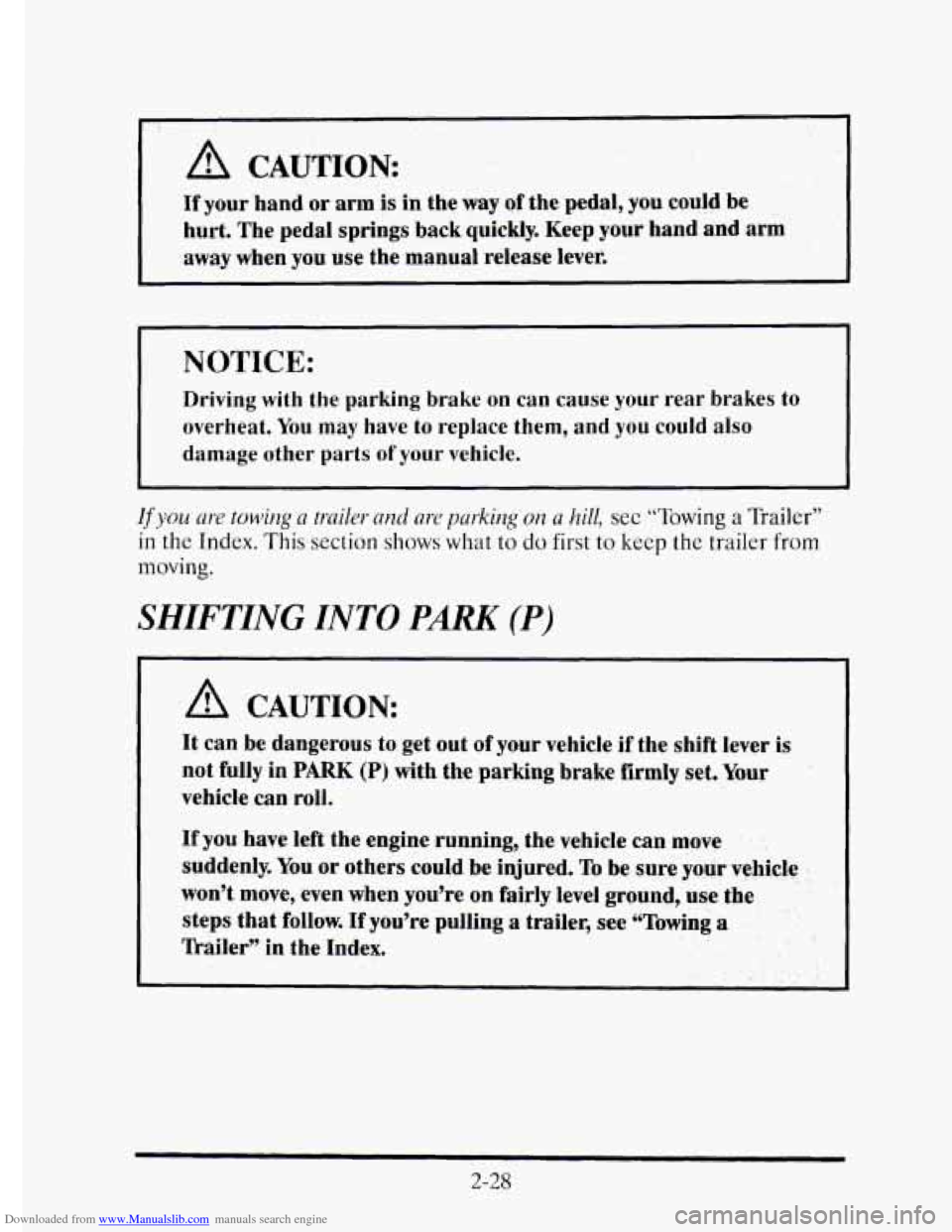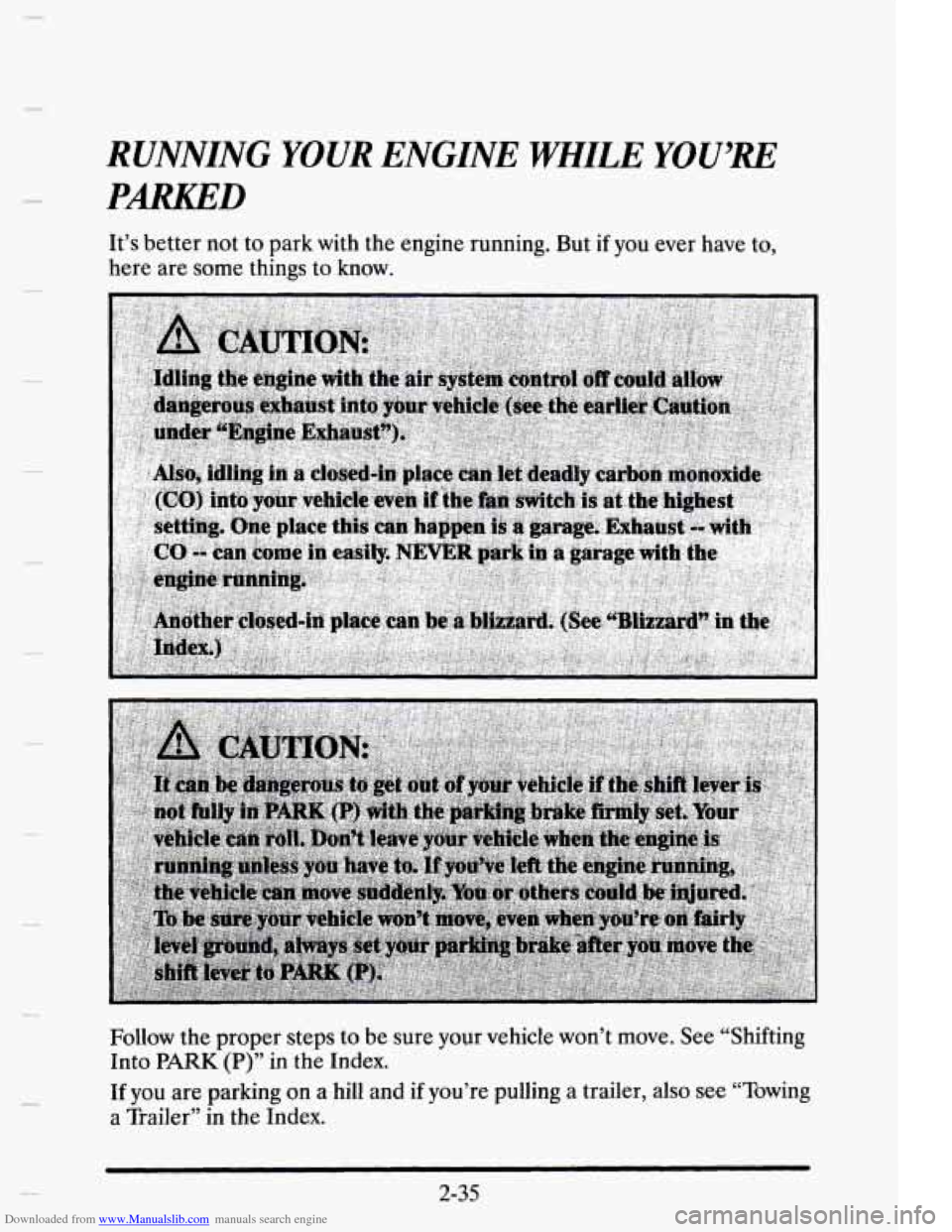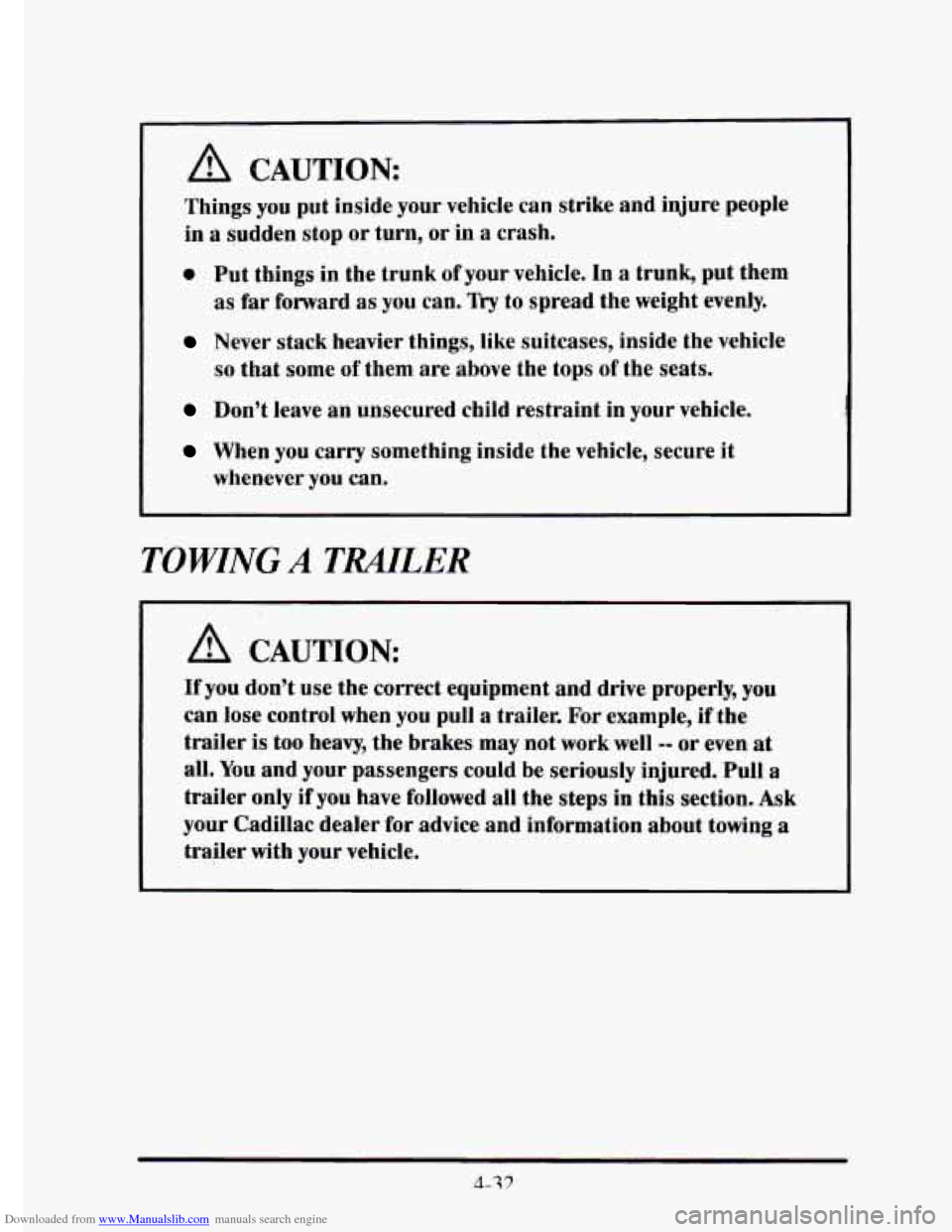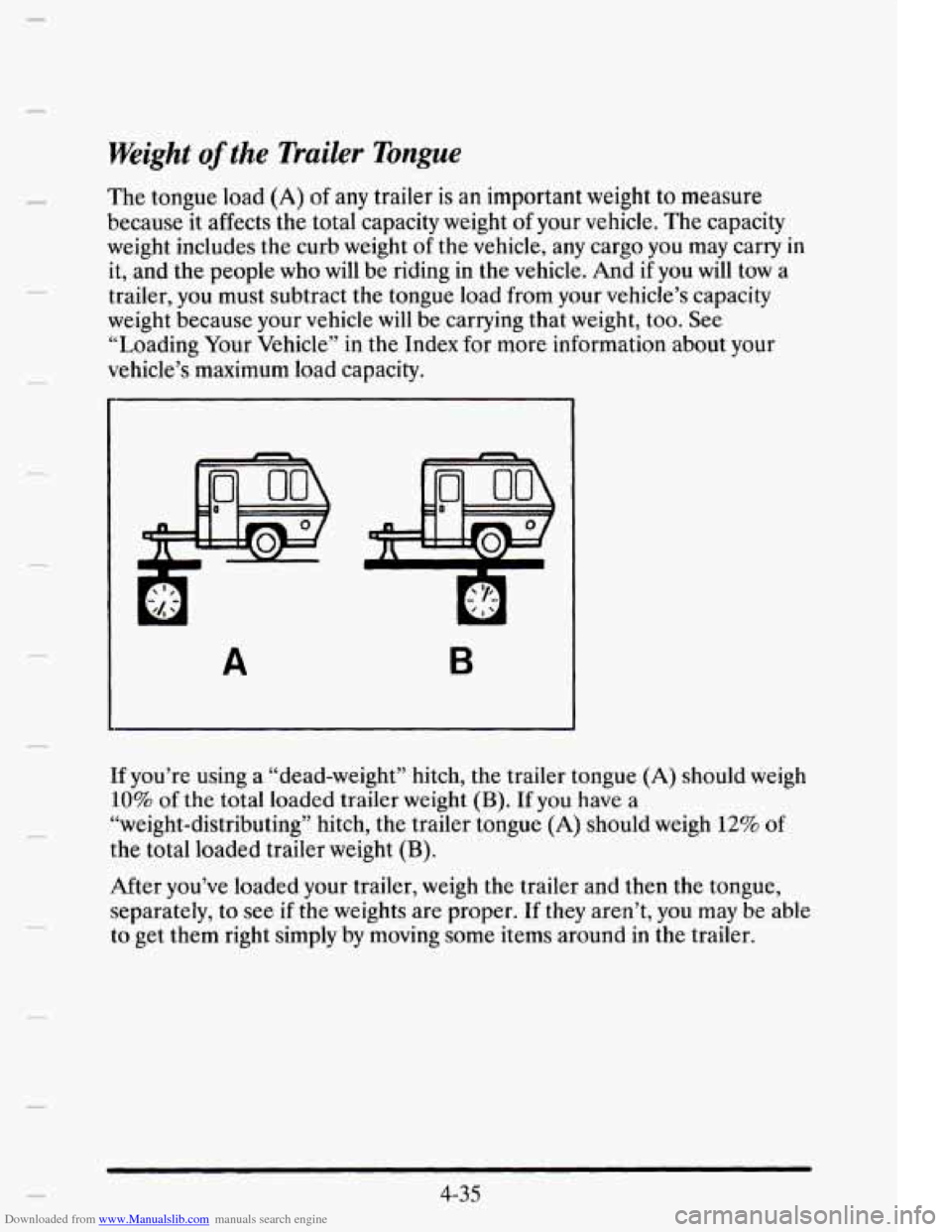1995 CADILLAC ELDORADO trailer
[x] Cancel search: trailerPage 89 of 395

Downloaded from www.Manualslib.com manuals search engine If you’re ever driving and you get the PASS-KEY MALFUNCTION
message
you will be able to restart your engine if you turn it off. Your
PASS-Key% system, however, is not working properly and must be
serviced by your Cadillac dealer. Your vchicle is not protected by the
PASS-K~Y~II system.
If you lose or damage a PASS-Key‘II ignition ke , see your Cadillac
dealer or
a locksmith who can service PASS-Key I1 to have a new key
made.
J
NOTICE:
Your modern Cadillac doesn’t need an elaborate “break-in.” But
it will perform better in the long run if you follow these
guidelines:
Don’t drive at any one speed -- fast or slow -- for the first
500 miles (804 km). Don’t make full-throttle starts.
0 Avoid making hard stops for the first 200 miles (322 km) or
so. During this t.ime your new brake linings aren’t yet broken
in. Hard stops with new linings can mean premature wear
and earlier replacement. Follow this “breaking-in” guideline
every time you get new brake linings.
0 Don’t tow a trailer during “break-in.” See “Towing a Trailer”
in the Index for more information.
2- 18
Page 96 of 395

Downloaded from www.Manualslib.com manuals search engine 3
L
I NOTICE:
Damage to your transaxle caused by shifting out of PARK (P) or
NEUTRAL (N) with the engine racing isn’t covered by your
warranty.
AUTOMATIC
OVERDRIVE (@): This position is for normal driving. If
you need more power for passing, and you’re:
Going less than 35 mph (55 km/h), push your accelerator pedal about
Going about 35 mph (55 km/h) or more, push the accelerator all the
halfway
down.
way down.
You’ll shift down to the next gear and have more power.
NOTICE:
If your vehicle seems to start up rather slowly, or if it doesn’t
seem to shift gears as you accelerate, something may be
wrong with
a transaxle system sensor. If you drive very far
that way, your vehicle can be damaged. So if this happens,
have your vehicle serviced right away. Until then, you can use
SECOND
(2) when you are driving less than 35 mph (55 km/h)
and AUTOMATIC
OVERDRIVE (@) for higher speeds.
THIRD
(3): This position limits upshifting and will not allow you to shift
into AUTOMATIC OVERDRIVE
(@).
Here are examples for using THIRD (3) instead of AUTOMATIC
OVERDRIVE
(a):
0 When driving on hilly, winding roads.
0 When towing a trailer, so there is less shifting between gears.
0 When going down a steep hill.
2-25
Page 99 of 395

Downloaded from www.Manualslib.com manuals search engine A, CAUTION:
If your hand or arm is in the way of the pedal, you could be
hurt.
The pedal springs back quickly. Keep your hand and arm
away when
you use the manual release lever.
I NOTICE:
Driving with the parking brake on can cause your rear brakes to
overheat. You may have to replace them, and you could also
damage other parts
of your vehicle.
If you are towirg u truiler and are parking on a hill, see “Towing a Trailer”
in the Index. This section slmws what to do first to kecp the trailer from
moving.
SHIFTING INTO PARK (P)
A CAUTION:
It can be dangerous to get out of your vehicle if the shift lever is
not fully in PARK (P) with the parking brake firmly set. Your
vehicle can roll.
If you have left the engine running, the vehicle can move ’’
suddenly. You or others could be injured. To be sure your vehicle
won’t
move, even when you’re on fairly level ground, use the
steps that follow.
If you’re pulling a trailer, see “Towing a
ll-ailer” in the Index.
.. ...
2-28
Page 106 of 395

Downloaded from www.Manualslib.com manuals search engine RUNNING YOUR ENGINE WHILE YOU’RE
PARKED
It’s better not to park with the engine running. But if you ever have to,
here are some things to know.
c.
Follow the proper steps to be sure your vehicle won’t move. See “Shifting
Into
PARK (P)” in the Index.
If you are parking on a hill and if you’re pulling a trailer, also see “Towing
a Trailer” in the Index.
2-35
Page 219 of 395

Downloaded from www.Manualslib.com manuals search engine A CAUTION
Things you put inside your vehicle can strike and injure people
in a sudden stop or turn, or in a crash.
0 Put things in the trunk of your vehicle. In a trunk, put them
as far forward as you can. ‘Ry to spread the weight evenly.
Never stack heavier things, like suitcases, inside the vehicle
so that some of them are above the tops of the seats.
Don’t leave an unsecured child restraint in your vehicle.
When you carry something inside the vehicle, secure it
whenever you can.
TOWING A TRAILER
A CAUTION:
If you don’t use the correct equipment and drive properIy, you
can lose control when you pull a trailer. For example, if the
trailer
is too heavy, the brakes may not work well -- or even at
all. You and your passengers could be seriously injured. Pull a
trailer only if you have followed all the steps in this section. Ask
your Cadillac dealer for advice and information about towing a
trailer with your vehicle.
Page 220 of 395

Downloaded from www.Manualslib.com manuals search engine NOTICE:
Pulling a trailer improperly can damage your vehicle and result
in costly repairs not covered by your warranty. To pull a trailer
correctly, follow the advice in this part, and see your Cadillac
dealer for important information about towing a trailer with
your vehicle.
Your vehicle can tow a trailer if it is equipped with the Northstar 4.6L
engine and proper trailer towing equipment. To identify what the vehicle
trailering capacity
is for your vehicle, you should read the information in
“Weight of the Trailer” that appears later in this section. But trailering is
different than just driving your vehicle by itself. Trailering means changes
in handling, durability, and fuel economy. Successful, safe trailering takes
correct equipment, and it has to be used properly.
That’s the reason for this part. In it are many time-tested, important
trailering tips and safety rules. Many
of these are important for your
safety and that
of your passengers. So please read this section carefully
before you pull
a trailer.
Load-pulling components such as the engine, transaxle, wheel assemblies,
and tires are forced to work harder against the drag
of the added weight.
The engine is required
to operate at relatively higher speeds and under
greater loads, generating extra heat. What’s more, the trailer adds
considerably
to wind resistance, increasing the pulling requirements.
If You Do Decide To Pull A nailer
If you do, here are some important points.
e There are many different laws, including speed limit restrictions,
having to do with trailering. Make sure your rig will
be legal, not only
where you live but
also where you’ll be driving. A good source for this
information can be state or provincial police.
Consider using a sway control.
4-33
Page 221 of 395

Downloaded from www.Manualslib.com manuals search engine You can ask a hitch dealer about sway controls.
0 Don’t tow a trailer at all during the first 1000 miles (1 600 km) your
new vehicle
is driven. Your engine, axle or other parts could be
damaged.
drive over
50 mph (80 km/h) and don’t make starts at full throttle. This
helps your engine and other parts
of your vehicle wear in at the
heavier loads.
Then, during the first SO0 miles (800 km) that you tow a trailer, don’t
0 Obey speed limit restrictions when towing a trailer. Don’t drive faster
than the maximum posted speed for trailers (or no more
than 55 mph
(90 km/h)) to save wear on your vehicle’s parts.
Three important considerations have to
do with weight:
Weight of the Trailer
How heavy can a trailer safely be?
It should never weigh more than 1,000 pounds
(450 kg) total, including
the load. But even that can be too heavy.
It depends on how you plan to use your rig. For example, speed, altitude,
road grades, outside temperature and how much your vehicle is used
to
pull a trailer are all important. And, it can also depend on any special
equipment that you have on your vehicle.
You can ask your dealer for our trailering information or advice, or you
can write
us at: Cadillac Consumer Relations Center, Cadillac Motor Car
Division, 30009 Van Dyke,
PO. Box 9025, Warren, MI 48090-9025.
In Canada, write
to: General Motors of Canada Limited. Customer
Assistance Center,
1908 Colonel Sam Drive, Oshawa, Ontario LlH 8P7.
4-34
Page 222 of 395

Downloaded from www.Manualslib.com manuals search engine n
Weight of the Trailer Tongue
The tongue load (A) of any trailer is an important weight to measure
because it affects the total capacity weight
of your vehicle. The capacity
weight includes
the curb weight of the vehicle, any cargo you may carry in
it, and the people
who will be riding in the vehicle. And if you will tow a
trailer, you must subtract the tongue load from your vehicle’s capacity
weight because your vehicle will be carrying that weight,
too. See
“Loading Your Vehicle”
in the Index for more information about your
A
vehicle’smaximum load capacity.
If you’re using a “dead-weight” hitch, the trailer tongue (A) should weigh
:LO% of the total loaded trailer weight (B). If you have a
“weight-distributing” hitch, the trailer tongue (A) should weigh
12% of
the total loaded trailer weight (B).
After you’ve loaded your trailer, weigh the trailer and then the tongue,
separately, to
see if the weights are proper. If they aren’t, you may be able
to get them right simply by moving some items around in the trailer.
4-35